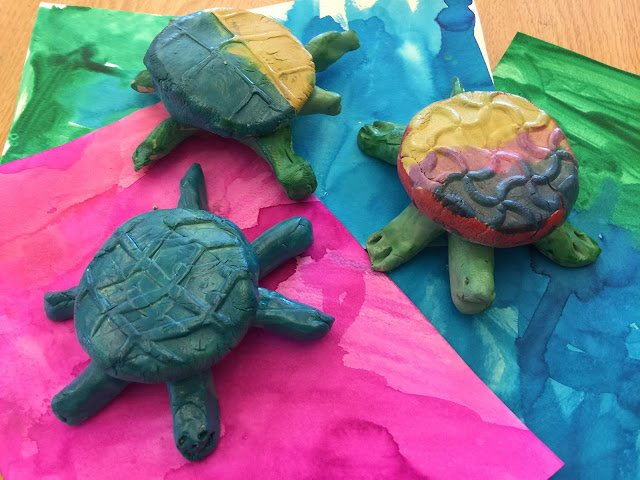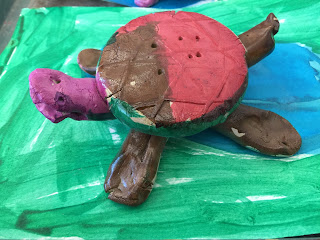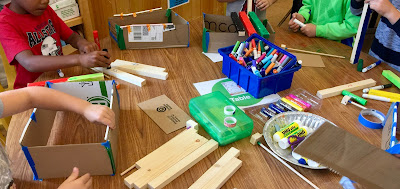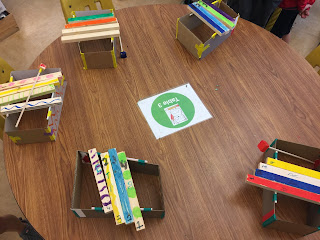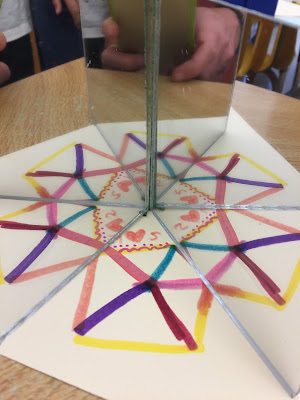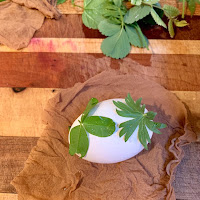PaperSeed Foundation is excited to inform you that the results of this year’s Marin County Recycled Materials Art Competition are in!
This year’s submissions were outstanding and there were ties in more than one category that required a special round of judging!
Group Category:
K-1st Winner: Sarah Vattuone’s Kindergarten Class- Reed Elementary
Runner Up: Barbara Libby-Steinmann’s Kindergarten Group- Bacich Elementary
Honorable Mention: Wendy Jawor’s First Grade Class- Reed Elementary
2nd-3rd Winner: Carrie Morgan’s 3rd Grade Class- Edna Maguire
Runner Up: Barbara Libby-Steinmann’s 2nd Grade Group- Bacich Elementary
Honorable Mention: Vallecito Green Team, Recycled Theater
4th-5th: Barbara Libby-Steinmann’s 4th Grade Group- Bacich Elementary
Congratulations to Bacich Elementary Art Teacher Mrs. Libby and her students for their creative, innovative, upcycled projects. Kindergarten (Aluminum Can Robots) , 2nd grade (Plastic Bottles Garden Ornaments), and 4th grade (See-Stunners). As a result, Ms. Libby has won a $500 grant for her art program.
4th-5th: Barbara Libby-Steinmann’s 4th Grade Group- Bacich Elementary
Congratulations to Bacich Elementary Art Teacher Mrs. Libby and her students for their creative, innovative, upcycled projects. Kindergarten (Aluminum Can Robots) , 2nd grade (Plastic Bottles Garden Ornaments), and 4th grade (See-Stunners). As a result, Ms. Libby has won a $500 grant for her art program.
Transitional Kindergarten: Texture Clay Turtles
TK Students had the opportunity to create three-dimensional turtles out of air-dry clay. To create an interesting texture for the turtle's shell, students stepped on a clay ball to imprint the texture of the sole of their shoes. Students viewed and compared the variety of textures everyone's shoe had left behind. Practicing rolling coils for the turtle's legs, head and tail was yet another clay molding technique students used. After the clay had dried, students painted their turtles in vibrant colors using liquid water colors. A coat of clear varnish finished the turtles with a nice shine.
Kindergarten: Symmetrical Monsters
Symmetry is when one shape becomes exactly like another if you flip, slide or turn it. The simplest type of symmetry is "rteflection" (or "mirror") symmetry. There is also rotational symmetry and point symmetry.
Kindergarten students were introduce to bilateral symmetry and practiced cutting symmetrical shapes by folding a piece of paper in half. Students were surprised to see a mirror image of the other half.
Kindergarten students were introduce to bilateral symmetry and practiced cutting symmetrical shapes by folding a piece of paper in half. Students were surprised to see a mirror image of the other half.
With a piece of 9"x12" construction paper folded in half, scissors, glue, markers and a bit of imagination, students crated silhouettes of silly, symmetrical monsters. Students decorated their monsters with symmetrical facial features, horns, ears, fangs, arms, legs, etc. to the left and to the right of the center line of symmetry.
1st GRADE: Arts Integration and STEAM: Exploration of Light and Sound
This 1st grade unit of Arts Integration and STEAM support the Next Generation Science Standards of "Light and Sound". First grade teachers worked collaboratively with the teacher Mrs. Libby, and at the same time receive professional development from artist/scientist-in-residence, Modesto Tamez. The project provided training for the teachers with the expectation that the teachers will be able to continue independently.
Modesto Tamez's residency at Bacich Elementary school was funded by Artists Teaching Art (ATA) and KSD PTA. ATA is an arts education program developed by the Sausalito Art Festival Foundation (SAFF) to serve students K-12 in both public and private schools throughout Marin County.
As California schools transition to the Common Core Standards, ATA understands that arts integration is an important part of this transition. ATA along with participating schools, teachers and professional artists collaborate to create a variety of artist-in-residence projects designed to inspire children to think differently about core subjects such as, math, science, history, geography, literature and art through project based learning. The program supports deeper learning and thinking by connecting the core subject to an art form while maintaining the integrity of both the core subject and the artistic process.
Modesto Tamez has over 40 years of experience as an artist, educator and scientist. Modesto has been part of a team of educators at the Teacher Institute at the Exploratorium in San Francisco. He leads professional development with science teachers of all levels. Modesto has had the opportunity to export what he does in San Francisco to many countries throughout the world by doing teacher training in over a dozen countries.
The collaborative, team-taught unit of study consisted of two 60 minutes lessons exploring the essential question: "What is sound?", as well as one 60 min lesson of inquiry exploring the phenomena's of light, and the essential question: "What does a mirror do?"
To hook students in the investigation of sound, Mrs. Libby and Mr. Tamez planned, and conducted short, hands-on activities to provide students with evidence that vibrating materials can make sound, and that sound can make materials vibrate.
Popsicle stick harmonica: Students created simple harmonicas out of popsicle sticks, tape and rubber bands. Students practiced making sounds with harmonicas. During peer and class discussion following questions were explored: What do you hear? Why does it make sounds? How can you make different sound (pitch, high low).
Students explored materials to realize that sound is vibration. Furthermore, students grasp the concept that long objects/materials make low sounds, whereas short ones produce high sounds.
To round of the study on sound, students built a simple xylophone out of cardboard and wood. Students personalize and decorated their xylophones in artistic, aesthetically pleasing ways.
The third session with artist/scientist-in-residence Modesto Tames, focused on exploration of light. Students experimented with materials which allow light to pass through them, and with others that allow only some light through, and others that block all the light. Modesto Tamez demonstrated that mirrors can be used to redirect a light beam. (Boundary: The idea that light travels from place to place is developed through experiences with light sources, mirrors, and shadows, but no attempt was made to discuss the speed of light).
Mirror Walk: Students used one small mirror held close to their faces below their eyes, to walk around classroom. Students explore the world around them through the upside-down image reflection in the mirror. Students were guided in the exploration how mirrors work. Students used artistic expressions to experiment with mirror reflection and duplication of images.
As a grand finally, students built, and create stunning kaleidoscopes, using simple materials such as: reflective mylar, tape, translucent tissue paper, and markers to design colorful patterns.
This 1st grade unit of Arts Integration and STEAM support the Next Generation Science Standards of "Light and Sound". First grade teachers worked collaboratively with the teacher Mrs. Libby, and at the same time receive professional development from artist/scientist-in-residence, Modesto Tamez. The project provided training for the teachers with the expectation that the teachers will be able to continue independently.
Modesto Tamez has over 40 years of experience as an artist, educator and scientist. Modesto has been part of a team of educators at the Teacher Institute at the Exploratorium in San Francisco. He leads professional development with science teachers of all levels. Modesto has had the opportunity to export what he does in San Francisco to many countries throughout the world by doing teacher training in over a dozen countries.
Modesto Tamez's residency at Bacich Elementary school was funded by Artists Teaching Art (ATA) and KSD PTA. ATA is an arts education program developed by the Sausalito Art Festival Foundation (SAFF) to serve students K-12 in both public and private schools throughout Marin County.
As California schools transition to the Common Core Standards, ATA understands that arts integration is an important part of this transition. ATA along with participating schools, teachers and professional artists collaborate to create a variety of artist-in-residence projects designed to inspire children to think differently about core subjects such as, math, science, history, geography, literature and art through project based learning. The program supports deeper learning and thinking by connecting the core subject to an art form while maintaining the integrity of both the core subject and the artistic process.
The collaborative, team-taught unit of study consisted of two 60 minutes lessons exploring the essential question: "What is sound?", as well as one 60 min lesson of inquiry exploring the phenomena's of light, and the essential question: "What does a mirror do?"
Popsicle stick harmonica: Students created simple harmonicas out of popsicle sticks, tape and rubber bands. Students practiced making sounds with harmonicas. During peer and class discussion following questions were explored: What do you hear? Why does it make sounds? How can you make different sound (pitch, high low).
Students explored materials to realize that sound is vibration. Furthermore, students grasp the concept that long objects/materials make low sounds, whereas short ones produce high sounds.
To round of the study on sound, students built a simple xylophone out of cardboard and wood. Students personalize and decorated their xylophones in artistic, aesthetically pleasing ways.
The third session with artist/scientist-in-residence Modesto Tames, focused on exploration of light. Students experimented with materials which allow light to pass through them, and with others that allow only some light through, and others that block all the light. Modesto Tamez demonstrated that mirrors can be used to redirect a light beam. (Boundary: The idea that light travels from place to place is developed through experiences with light sources, mirrors, and shadows, but no attempt was made to discuss the speed of light).
Mirror Walk: Students used one small mirror held close to their faces below their eyes, to walk around classroom. Students explore the world around them through the upside-down image reflection in the mirror. Students were guided in the exploration how mirrors work. Students used artistic expressions to experiment with mirror reflection and duplication of images.
2nd GRADE: Kinetic Sculpture inspired by A. Calder
Second grade students created sculptures made out of wood and wire. Constructing a kinetic sculpture was a study in balance and engineering, making a connection to the second grade science curriculum “balance and motion”, as well as an introduction to the American sculptor and artist, Alexander Calder,
Born into a family of artists, Calder created his first sculpture at age four. In his career, Calder created many sculptures, mobiles and stabiles, paintings, jewelry and significant toys. A fascination with the circus led to a toy circuses made from wire, string, rubber and found objects, which in turn evolved into wire sculptures, and kinetic art. Calder’s keen eye for balance in his sculptures both large and small, ultimately resulted in the first “mobiles”. His first public commission was a pair of mobiles in the Berkshire Museum in Pittsfield, Massachusetts, in 1937.
Second grade students created sculptures made out of wood and wire. Constructing a kinetic sculpture was a study in balance and engineering, making a connection to the second grade science curriculum “balance and motion”, as well as an introduction to the American sculptor and artist, Alexander Calder,
Born into a family of artists, Calder created his first sculpture at age four. In his career, Calder created many sculptures, mobiles and stabiles, paintings, jewelry and significant toys. A fascination with the circus led to a toy circuses made from wire, string, rubber and found objects, which in turn evolved into wire sculptures, and kinetic art. Calder’s keen eye for balance in his sculptures both large and small, ultimately resulted in the first “mobiles”. His first public commission was a pair of mobiles in the Berkshire Museum in Pittsfield, Massachusetts, in 1937.
3rd GRADE Paper Making
The first papers are thought to have been made from mulberry and other bast fibers along with old rags and hemp waste in 2nd century China. Later in the West, paper was largely made from old clothes. Similarly, the third grade students made their paper from recycled materials - newspaper, cotton rags, and plant fibers.
In a collaborative effort, students created gorgeous handmade papers with fancy deckle edges.
3rd GRADE Paper Making Extension, Fantasy Birds
Easily some of the most stunningly colorful animals on earth, birds are a perfect inspirational source for fantasy and imagination! Students painted brilliantly colored birds in oil pastels onto their handmade papers. Using watercolors and fine tip sharpie pens students created a second piece depicting fantastical birds.
This project was balance of form, imagination and technique. Students compared pros and cons of working with a dry medium (oil pastels), and wet medium (water color).
The watercolor media allowed student to explore different techniques such as wet-on-wet color flow, dry brush, and masking the shapes for the eyes of the bird. The oil pastels provided students with a bit more color contro,l and simple color mixing using fingers as a blending tool.
The watercolor media allowed student to explore different techniques such as wet-on-wet color flow, dry brush, and masking the shapes for the eyes of the bird. The oil pastels provided students with a bit more color contro,l and simple color mixing using fingers as a blending tool.
4th GRADE: Australian Aboriginal Bark Painting
4th grade students studied Australian Aboriginal Bark Art. Students explored the unique art of Australia’s Aborigines from prehistoric cave art to the paintings of the contemporary artists. Students learned that the Aborigines use art as a way to communicate and a way to tell stories, known as "dreamings." Students were introduced to symbols used in Aboriginal bark paintings and used some of those symbols in their own artwork. Students used tempera paint on brown paper to create contemporary bark paintings based on the Aboriginal "dreamings". In the style of the aboriginal artists, students used a variety of sticks and dowels to apply tempera paint in the distinctive pointillism technique.




